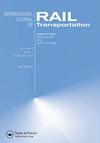Investigating the effect of using softer rail-pads on ground-borne vibration from underground railways
IF 3.6
2区 工程技术
Q2 TRANSPORTATION SCIENCE & TECHNOLOGY
International Journal of Rail Transportation
Pub Date : 2023-09-19
DOI:10.1080/23248378.2023.2256735
引用次数: 0
Abstract
ABSTRACTIn this study, a series of vibration measurements were performed on a section of one of the lines of the Doha Metro to explore the effect of changing rail-pads from conventional higher stiffness under-rail pads to lower stiffness web-supporting pads on the vibration levels at the free surface. Vibration levels were measured for the two cases of lower and higher stiffness’ pads at the free surface directly above the railway track. Additionally, vibration levels were measured in the railway tunnel to investigate the effect of changing rail-pad’s stiffness on the vibration levels at different locations inside the tunnel. Vibration measurements due to moving trains from the two cases were processed and analysed to calculate the Insertion Gain (IG) of vibration at the free surface and at the other locations. It was found that the use of softer rail-pads has resulted in reduction in the vibration levels at the free surface by about 10 dB for most frequencies in the range 40–200 Hz. Further numerical investigation was conducted to simulate the railway section under consideration. To simulate the track fastening system accurately, the dynamic stiffness of the rail-pads for the two cases was estimated using the measurement of vibration of rails due to impact hammer excitation and measurement of axle-box accelerations of a moving trains. The parameters of problem at-hand were used as inputs to the numerical Pipe-in-Pipe (PiP) model to calculate the insertion gain numerically at the free surface and this showed good match with the results from the measurements.KEYWORDS: Ground-borne vibrationcountermeasuresrail-padsvibration measurementsPiP model AcknowledgementsThe authors would like to acknowledge the funding from Qatar Rail through grant number QUEX-CENG-QR-21/22-1. The study received strong support by Qatar Rail in providing and supporting all logistics for the measurements.Disclosure statementNo potential conflict of interest was reported by the authors.研究使用软轨垫对地下铁路地面振动的影响
摘要本研究通过对多哈地铁某路段的振动测量,探讨了将常规高刚度轨下垫块改为低刚度支撑网垫块对自由面振动水平的影响。在铁路轨道正上方的自由表面上测量了低刚度和高刚度两种情况下的振动水平。此外,还在铁路隧道中测量了振动水平,研究了改变轨道垫刚度对隧道内不同位置振动水平的影响。对这两种情况下列车运动时的振动测量结果进行了处理和分析,以计算自由表面和其他位置振动的插入增益(IG)。研究发现,在40至200赫兹的频率范围内,使用较软的轨道垫可使自由表面的振动水平降低约10分贝。对所考虑的路段进行了进一步的数值模拟。为了准确地模拟轨道紧固系统,通过测量轨道在冲击锤激励下的振动和测量移动列车的轴箱加速度,估计了两种情况下轨垫的动刚度。将现有问题的参数作为数值模型的输入,对自由表面的插入增益进行了数值计算,结果与实测结果吻合较好。关键词:地面振动对策轨道垫振动测量spip模型致谢作者感谢卡塔尔铁路的资助,资助号为quex - cengr - qr -21/22-1。这项研究得到了卡塔尔铁路公司的大力支持,为测量提供了所有后勤支持。披露声明作者未报告潜在的利益冲突。
本文章由计算机程序翻译,如有差异,请以英文原文为准。
求助全文
约1分钟内获得全文
求助全文
来源期刊

International Journal of Rail Transportation
TRANSPORTATION SCIENCE & TECHNOLOGY-
CiteScore
6.90
自引率
15.00%
发文量
51
期刊介绍:
The unprecedented modernization and expansion of rail transportation system will require substantial new efforts in scientific research for field-deployable technologies. The International Journal of Rail Transportation (IJRT) aims to provide an open forum for scientists, researchers, and engineers in the world to promote the exchange of the latest scientific and technological innovations in rail transportation; and to advance the state-of-the-art engineering and practices for various types of rail based transportation systems. IJRT covers all main areas of rail vehicle, infrastructure, traction power, operation, communication, and environment. The journal publishes original, significant articles on topics in dynamics and mechanics of rail vehicle, track, and bridge system; planning and design, construction, operation, inspection, and maintenance of rail infrastructure; train operation, control, scheduling and management; rail electrification; signalling and communication; and environmental impacts such as vibration and noise. The editorial policy of the new journal will abide by the highest level of standards in research rigor, ethics, and academic freedom. All published articles in IJRT have undergone rigorous peer review, based on initial editor screening and anonymous refereeing by independent experts. There are no page charges and colour figures are included in the online edition free of charge.
 求助内容:
求助内容: 应助结果提醒方式:
应助结果提醒方式:


